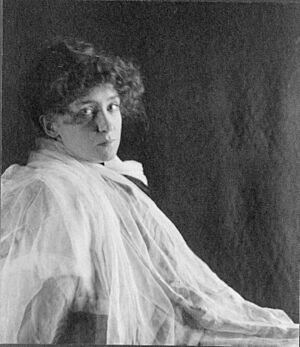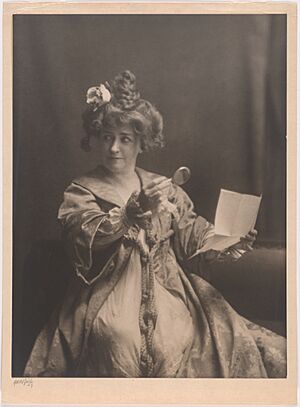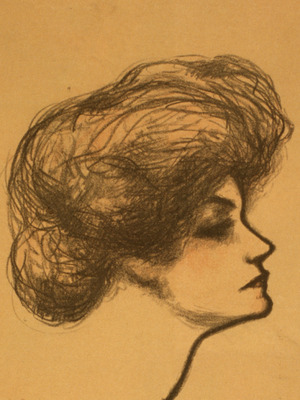Minnie Maddern Fiske facts for kids
Quick facts for kids
Minnie Maddern Fiske
|
|
|---|---|

"Mrs. Fiske: Love Finds the Way"
by Zaida Ben-Yusuf (1896) |
|
| Born |
Marie Augusta Davey
December 19, 1865 New Orleans, Louisiana, U.S.
|
| Died | February 15, 1932 (aged 66) Queens, New York City, U.S.
|
| Other names | Mrs. Fiske |
| Occupation |
|
| Spouse(s) |
LeGrand White
(m. 1882; div. 1888)Harrison Grey Fiske
(m. 1890) |
| Relatives | Emily Stevens (cousin) |
| Signature | |
Minnie Maddern Fiske (born Marie Augusta Davey; December 19, 1865 – February 15, 1932) was a very important American actress. She was known as one of the best performers in the late 1800s and early 1900s. People often called her simply Mrs. Fiske.
She was also a leader in the fight for artistic freedom in theater. She stood up against a powerful group called the Theatrical Syndicate. Many people thought she was the most important actress in America during the early 1900s. She helped introduce American audiences to the plays of Henrik Ibsen, a famous writer from Norway.
Contents
Minnie Fiske's Acting Career
Minnie Maddern Fiske was born in New Orleans, Louisiana. Her father, Thomas Davey, was a stage manager, and her mother, Lizzie Maddern, was an actress. Because she came from a family of performers, Minnie started acting very young.
She had her first professional show at just three years old. She played the Duke of York in the play Richard III. When she was four, she made her debut in New York in a play called A Sheep in Wolf's Clothing. As a child, she traveled a lot and performed in many shows. She also went to different schools. She was a child prodigy, meaning she was very talented at a young age.
When she was 16, Minnie became a leading lady in plays. She got the main role of Chip in Fogg's Ferry. People noticed her for her unique beauty and singing voice. She starred in the opening of the Hanover Opera House in 1887.
Minnie married LeGrand White, a musician from Fogg's Ferry, but they divorced soon after. In 1890, she married Harrison Grey Fiske. She took three years off from acting. In 1893, she returned to the theater, not just as an actress, but also as a playwright and director. She wrote one-act plays like A Light for St. Agnes and The Rose. She also worked with her husband on a play called Fontenelle. Her husband, Mr. Fiske, directed almost all of her plays after they were married.
Minnie Maddern Fiske became very famous for playing Nora in A Doll's House by Henrik Ibsen. Her amazing performance helped make Ibsen's plays popular in America. She is also well-known for playing Becky Sharp in the 1899 play Becky Sharp. This play was based on the famous book Vanity Fair.
Minnie Fiske had many successful shows on Broadway. Some of her famous roles were in Tess of the d'Urbervilles (1897), Love Finds the Way (1898), and Hedda Gabler (1903). She also performed in plays she wrote herself. She acted in all kinds of shows, from funny comedies to serious tragedies. Her last Broadway show was in 1930, where she played Mrs. Malaprop in The Rivals.
In the mid-1910s, Mrs. Fiske also starred in two movies. These movies were based on her popular stage plays: Tess of the d'Urbervilles (1913) and Vanity Fair (1915). Even though the movies were successful, she didn't think she was good at acting in films. So, she decided not to do any more movie roles.
Minnie Fiske was a leader in bringing realism to acting. This meant showing characters and situations in a very honest and true-to-life way. She loved performing Ibsen's plays because they showed human nature so truthfully. She believed Ibsen's plays were better for actors to study than Shakespeare's. She once said that Ibsen's characters were like puzzles that needed a lot of thought to understand.
In 1916, Minnie Fiske wrote an article where she praised Charlie Chaplin. She was one of the first people to see him as a serious artist, not just a comedian. She wrote that Chaplin had an amazing imagination and perfect acting skills.
Even though she was a highly praised actress, Minnie Fiske died without much money. This was because she spent 12 years fighting against a powerful group called the Theatrical Syndicate. This group controlled most of the big theaters in the U.S. They decided which plays would be shown and which actors would be hired. Minnie Fiske fought for artistic freedom, which meant she often had to perform in smaller, less fancy places like churches or skating rinks.
Caring for Animals
Besides her fight for artistic freedom, Minnie Fiske was also a strong supporter of animal welfare. She cared deeply about animals and worked to protect them. She was interested in groups like the American Society for the Prevention of Cruelty to Animals. She was known for picking up stray dogs and taking care of them.
She spoke out against wearing hats decorated with feathers from birds like snowy and great egrets. She also made people aware of the cruel ways animals were trapped for fur. She even helped change how cattle were treated on farms. Because she was famous and loved, many people followed her example. This helped her make a big difference in animal rights.
Minnie Fiske was named one of the twelve greatest living American women twice. This was because of her fight for animal rights and her amazing acting talent. She was first honored in 1923 and again in 1931. The famous writer Mark Twain even wrote a story called "A Horse's Tale" at her request. He wrote it to help stop bullfighting in Spain.
Minnie Fiske was a strict vegetarian. She was also against vivisection, which is experimenting on live animals.
Later Life and Family
Minnie Fiske passed away from heart failure when she was 66 years old in Queens, New York. She and her husband, Harrison, did not have any children of their own. Around 1915, they adopted a baby boy.
Minnie Fiske had several relatives who were also involved in theater. The actress Emily Stevens was her cousin. Elizabeth Maddern, who was the first wife of author Jack London, was also her cousin. Another cousin was Robert Stevens, who directed the Rochester Community Players for many years.
Legacy and Honors
During World War II, a ship called the SS Minnie M. Fiske was built in her honor.
In 1961, her personal papers were given to the United States Library of Congress. There were 23,000 items, weighing a lot!
Selected Plays and Performances
- Hunted Down (1871)
- Fogg's Ferry (1882)
- Caprice (1884)
- Hester Crewe (1893)
- A Doll's House (1894, 1896, 1902)
- A Light From St. Agnes (1896, 1905)
- Love Finds the Way (1896, 1898)
- Tess of D'Urbervilles (1897, 1902, 1907)
- Becky Sharp (1899, 1904, 1911)
- Miranda of the Balcony (1901)
- Hedda Gabler (1903, 1904)
- Leah Kleschna (1904, 1907)
- The Rose (1905)
- The Eyes of the Heart (1905)
- The New York Idea (1906)
- Rosmersholm (1907)
- Salvation Nell (1908)
- The Pillars of Society (1910)
- Mrs. Bumpstead-Leigh (1911, 1914, 1929, 1932)
- The High Road (1912, 1913)
- Madame Sand (1917)
- Mis' Nelly of N' Orleans (1919)
- Wake Up, Jonathan! (1921)
- Helena's Boys (1923)
- The Rivals (1925, 1930)
- Ghosts (1927)
- Ladies of the Jury (1929, 1931)
See also
 In Spanish: Minnie Maddern Fiske para niños
In Spanish: Minnie Maddern Fiske para niños





